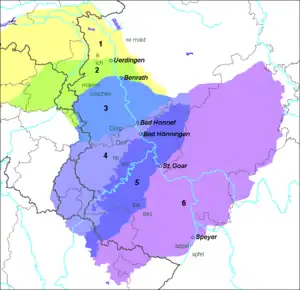Rhinelandic
Rhinelandic is a term occasionally used for linguistic varieties of a region on both sides of the Middle and Lower Rhine river in Central West Germany, Belgium, the Netherlands, and Luxembourg, including some varieties of the Limburgish language group, South Guelderish or Kleverlandish, Moselle Franconian and Ripuarian. The Local languages of villages or cities are commonly referred to as "the dialects" or "dialect". One of the meanings of Rhinelandic is that of a group of local languages in an area called the Rhineland. Another meaning is that of the regiolect being used by the people approximately of the same area.

Rhinelandic Local Languages
Alternatively, if Rhineland is seen as the territory of the former Prussian Rhine Province (1815/1816–1945), there are 5 dialect areas:[1]
- Kleverländisch
- South Low Franconian
- Ripuarian
- Moselle Franconian
- a small area with a part of Rhine Franconian
The Uerdingen line (Uerdinger Linie) separates Kleverländisch and East Bergish from South Low Franconian; the Benrath line (Benrather Linie) separates Low Franconian and Central Franconian; the Dorp/Dorf line (Dorp-Dorf-Linie or Eifelschranke) Ripuarian and Moselle Franconian; and the dat/das line (Hunsrückschranke) Moselle Franconian and Rhine Franconian.[2][1] One can't speak of a Rhenish dialect area.[1] Its northern areas are also covered by the more modern term of Meuse-Rhenish, which exclusively refers to the Low Franconian varieties mentioned above.
The eastern areas in the North are also said to speak Bergish, a term which has its roots in political history and regional pride rather than linguistic similarities. Likewise, the Eifel inhabitants say, they were speaking Eifelplatt, while linguists rather refer to the Ripuarian varieties of the North, and the Moselle-Franconian ones of the South of the Eifel.
All these local languages and local language groups existed long before Standard German, and developed in parallel since the latter came into existence. In the Rhineland, there are 7 dialect areas including a Palatine dialect island between Kleve and Goch, spoken in three village, formed in the 18th century :[2]
Rhinelandic Regiolect
Also the Regiolect of the Rhineland, geographically roughly coinciding with the former Prussian Rhine Province, is being called Rhinelandic. It is of comparatively recent origin, and derives from Standard German but takes up some lexical and grammatical and phonetic features of the local languages, that Standard German normally does not have. Most of those features are not used in other German regiolects, and are often hardly or not understood in other regiolect areas. Rhenish (Rheinisch) is a regiolect.[3]
See also
References
- Michael Elmentaler, Sprachgrenzen und Sprachschichtungen im Rheinland: Zur sprachlichen Genese des »Rheinischen«, in: Bernd Kortländer, Gunter E. Grimm (eds.), Joseph A. Kruse (series-ed.), »Rheinisch«: Zum Selbstverständnis einer Region (= Heinrich-Heine Institut Düsseldorf: Archiv, Bibliothek, Museum vol. 9), Verlag J. B. Metzler, Stuttgart / Weimar, 2001, p. 119ff., here p. 120ff.
-
- Dr. Georg Cornelissen (2008), Meine Oma spricht noch Platt: Wo bleibt der Dialekt im Rheinland? (in German), Köln: Greven Verlag, pp. 40f. [in the chapter Die Benrather Linie: Die „fränkischen“ Dialekte am Rhein und ihre Gliederung], ISBN 3-7743-0417-3
- "Dialekte im Rheinland". LVR-Institut für Landeskunde und Regionalgeschichte. Archived from the original on 7 December 2022. Retrieved 21 July 2023.
Peter Wiesinger, Strukturgeographische und strukturhistorische Untersuchungen zur Stellung der bergischen Mundarten zwischen Ripuarisch, Niederfränkisch und Westfälisch, in: Peter Wiesinger, edited by Franz Patocka, Strukturelle historische Dialektologie des Deutschen: Strukturhistorische und strukturgeographische Studien zur Vokalentwicklung deutscher Dialekte, Georg Olms Verlag, Hildesheim / Zürich / New York, 2017, p. 341–437, here p. 437. This paper by Wiesinger was originally published in: Neuere Forschungen in Linguistik und Philologie. Aus dem Kreise seiner Schüler Ludwig Erich Schmitt zum 65. Geburtstag gewidmet, 1975, p. 17–82. - Elvira Topalović, Julia Settinieri, Sprachliche Bildung (= LinguS - Linguistik und Schule: Von der Sprachtheorie zur Unterrichtspraxis vol. 8), Narr Francke Attempto Verlag, Tübingen, 2023, chapter 3.1 Innere und äußere Mehrsprachigkeit, in the definition of Standardvarietäten oder Standardlekte: „[...] Regiolekten (z. B. Rheinisch), Dialekten (z. B. Kölsch), [...]“